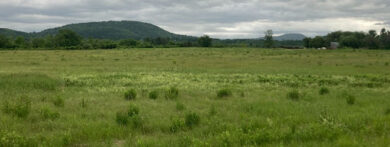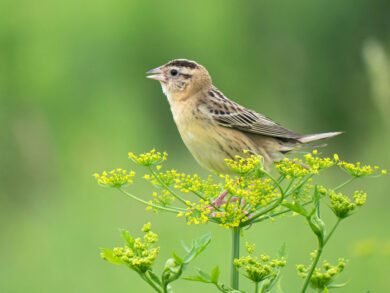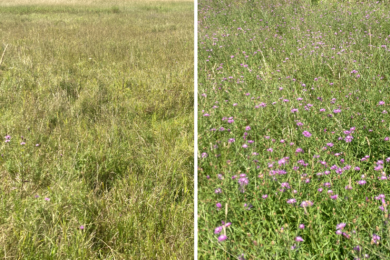
A Burgeoning Smooth Bedstraw (Galium mollugo – white flowers, center) infestation in Charlotte, VT. © Kevin Tolan
It’s an annual occurrence across the state happening earlier and earlier: the first hay harvest. Haying has become more intensive, and many acres are cut between two and four times per growing season. Frequent harvests are necessary to produce high-quality dairy cow forage. Unfortunately, this management regime doesn’t provide enough time for breeding birds, such as Bobolinks and Eastern Meadowlarks, to fledge young successfully. Delaying mowing until mid-July allows birds to nest at the cost of forage quality, and by extension, landowner income. Additionally, as the number of dairy farmers in Vermont continues to decline, it can be difficult to find someone to hay delayed fields.
In recent years, we’ve learned that delayed haying for bird conservation creates a dilemma. Fields can’t be cut when birds are nesting, but not cutting allows invasive plants to seed and spread freely. The rapid inundation of hayfields by invasive plants replaces the cover necessary for grassland birds to breed and makes entire fields unsuitable for Bobolinks and Eastern Meadowlarks. All of these factors combine to complicate the long-term conservation of grassland bird habitat.

Female Bobolink perched on invasive Poison Parsnip © Susan Elliot via iNaturalist
Grassland birds assess habitat quality based on vegetation structure, not species composition. Very few Northeastern hayfields are composed of native grasses and common forage grasses consist of the non-native timothy (Phleum pratense) and orchard grasses (Dactylis glomerata. Studies have even documented higher Bobolink abundances in grasslands comprised of non-native grasses, primarily because the structure resembles that of the nearly extirpated North American tallgrass prairie. Several invasive plant species rapidly alter the vegetative structure of fields. Smooth bedstraw, for instance, forms thick, knotted mats of growth that replace grasses and may impede fledglings’ movements. Reed canary grass, while superficially resembling suitable habitat, forms dense monocultures that prevent a structurally diverse vegetation community from growing.
One method of grassland restoration that isn’t commonly used in Vermont is prescribed burns. Fire is an integral part of ecosystems ranging from grasslands to forests, and is increasingly utilized in Vermont. Additionally, prescribed burns occur elsewhere in New England to maintain sandplain grasslands, such as Maine’s Kennebunk Plains which hosts Grasshopper Sparrows, Upland Sandpipers, Eastern Whip-Poor-Wills, Vesper Sparrows, and Eastern Meadowlarks. While it’s a promising restoration method for large grasslands in Vermont, logistical concerns and public attitudes toward prescribed burns may limit its usage.
Prioritizing invasive plant eradication should be a priority in all hayfields maintained for grassland birds to promote long-term site conservation. Unfortunately, the battle against invasive plants is a perennial, ongoing issue. Regularly monitoring a field’s vegetation facilitates a quick, targeted response to prevent an inundation. Placing a field on a rotation, such as delaying haying half of the field and switching every three years, can also provide nesting habitat (in the delayed portion) while managing against invasive plants in the other portion.

Left: hayfield vegetation. Right: the same field inundated by Spotted Knapweed (Centaurea stoebe) © Kevin Tolan
If you own or manage a grassland of at least ten acres, we encourage you to proactively ensure its long-term viability as nesting habitat. One simple step is to maintain a mowed five-meter strip along field edges, where invasions generally start. When an invasion does start, target it with frequent cuts to prevent seeding and “beat back” its growth. Once a wide-scale invasion occurs, take the field out of delay mowing for roughly three years and hay several times annually to prevent invasive plants from seeding, while depleting the seed bank. If machinery is used across several fields, rinse it off with water before leaving a field to prevent the introduction of seeds to subsequent sites.
VCE’s Grassland Ambassador program is redoubling efforts to address the emerging, pressing invasive plant issue as part of an upcoming project. Along with partners at Vermont Fish and Wildlife, we aim to better understand the impact of invasive vegetation on grassland birds and trial various management regimes to improve grassland habitat. Through this effort, we’ll also assist landowners with conserving their land for the long term through vegetation and bird monitoring, technical assistance, and information about existing financial assistance programs that facilitate delayed mowing, or the reestablishment and improvement of grassland habitat.
Grassland landowners who aren’t already in contact with our Grasslands Ambassador program, and are interested in learning more about grassland management and facilitating a site visit with VCE, please reach out to . We’re eager to kick off this effort by connecting and visiting with landowners across the state, both to provide management guidance and to form management guidance for this emerging issue.
